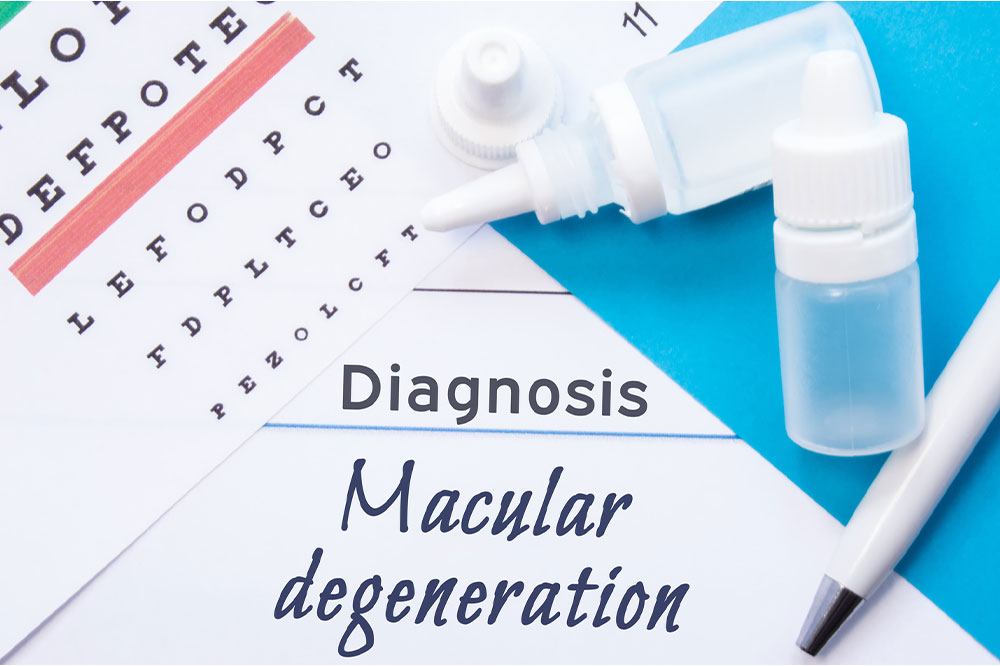
A brief overview on macular degeneration
Macular degeneration is a progressive disease that slowly damages the part of the eye called the macula, which is responsible for central vision. As a result, patients can no longer see clearly. Since the health condition most often occurs due to aging, it is also referred to as age-related macular degeneration or AMD. This article quickly discusses the types of AMD, its causes, treatment options, and nutrition tips for patients.
Types of macular degeneration
There are two main types of AMD, dry and wet:
- Dry AMD
The more common of the two, dry AMD occurs due to the thinning of the macula caused by advancing age. It could develop in three stages over several years and is more prevalent. - Wet AMD
This type of AMD occurs when the macula is damaged due to the growth of abnormal blood vessels at the back of the eye. It causes faster vision loss as compared to dry AMD but is rare.
Irrespective of the type, patients must visit a doctor immediately after noticing the symptoms.
Causes of macular degeneration
Various factors can lead to AMD, but the most common is aging. Individuals who are 50 or above have a higher risk of developing the disease. Other causes include eating meals high in saturated fats and uncontrolled high blood pressure or hypertension. Even genetics can play a role in triggering AMD .
Symptoms of macular degeneration
Since age-related macular degeneration is a progressive disease, the symptoms usually worsen over time. In the initial stages, one might have little or no issues with their vision. But over time, straight lines and objects start appearing wavy or distorted. Soon, one may express the need for brighter light, a blurred center of vision, and trouble with face recognition.
As symptoms worsen, patients start seeing black spots, mainly in the case of wet AMD, where certain macula cells die.
Diagnosis of macular degeneration
Doctors diagnose AMD using multiple methods. One way is to check for drusen: tiny yellow deposits under the retina that can increase the risk of contracting the disease. Amsler grid is another technique where patients are asked to look at a pattern of straight lines. If the lines appear wavy or are missing in parts, it is a sign of the disease.
Treatments for macular degeneration
There is no definite cure for age-related AMD, but treatments can control the disease by slowing its progression. The popular options include:
- Laser therapy
In this treatment, high-energy laser light is used to destroy the abnormal blood vessels in the eyes that grow due to AMD. - Anti-VEGF treatments
These are administered into the eyes to stop the growth of new blood vessels. It also prevents leakage from abnormal vessels that can lead to wet macular degeneration. - Vitamins
Studies recommend the intake of vitamins C and E, zinc, and copper to manage AMD. This option is mainly used to treat dry AMD and helps reduce the risk of vision loss drastically. - Vision aids
Special lenses are available that make nearby objects look bigger. Eyeglasses with special lenses, electronic glasses, reading magnifiers, and binocular glasses are other vision aids to use when diagnosed with AMD.
Doctors recommend a suitable treatment based on the severity of the condition, the patient’s age and health, and their tolerance to specific procedures. The type of AMD (dry or wet) will also determine the treatment option.
Nutrition for macular degeneration
There is no specific nutrition plan for AMD, but certain foods have nutrients that help manage the condition better.
- Omega-3 fatty acids
Researchers believe that inflammation may be a reason for AMD. Omega-3 fatty acids found in fish, nuts, and seeds help fight inflammation in the body while lowering cholesterol levels. - Antioxidants
Antioxidants are essential as they help the body fight cellular damage. Foods rich in vitamins A, C, and E, such as dark leafy vegetables, citrus fruits, certain oils, and seeds, are suitable options. - Copper and zinc
Zinc can be found in legumes, shellfish, and meat, while copper can be found in dark leafy greens, eggs, nuts, and seeds. These minerals boost eye health.
It is also essential to know what not to eat. Patients must avoid foods that contain trans fats and high-fat dairy products. Food that can cause inflammation in the body, such as sugary drinks and greasy food, must also be avoided.
Even though one cannot stop aging, which is the number one cause of macular degeneration, it is possible to reduce its impact with the correct precautions. The right foods and treatments can help patients live lives not entirely affected by the disease.




